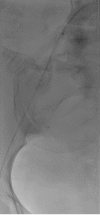Prophylactic occlusion balloon in placenta abnormalities: What every interventional radiologist needs to know
- PMID: 40746523
- PMCID: PMC12308548
- DOI: 10.4329/wjr.v17.i7.107737
Prophylactic occlusion balloon in placenta abnormalities: What every interventional radiologist needs to know
Abstract
Placenta abnormalities, which are collectively termed as placenta accreta spectrum (PAS), are increasing globally in the female population due to the large number of cesarean sections performed worldwide. PAS represents a rare but life-threatening occurrence that can lead to an increased risk of postpartum hemorrhage due to the abnormal infiltration of the chorionic villi in the uterine wall up to the adjacent structures. Performing a prophylactic occlusion of the iliac arteries for a brief amount of time using balloon-occlusion endovascular catheters in patients with PAS can help control unwanted blood losses during cesarean delivery or postpartum demolition surgery. The aim of this narrative minireview was to provide an overview of the aspects about prophylactic occlusion with endovascular balloons in patients with PAS and to analyze current evidence on this topic. In particular, this minireview included an overview of indications, patient selection, type of materials and devices used, technical advice and suggestions, clinical outcomes, and complications to give every interventional radiologist as well as every gynecologist and midwife all the information that is needed to address this particular condition in a safe and prompt manner.
Keywords: Balloon occlusion; Endovascular; Interventional radiology; Placenta accreta; Postpartum hemorrhage.
©The Author(s) 2025. Published by Baishideng Publishing Group Inc. All rights reserved.
Conflict of interest statement
Conflict-of-interest statement: All authors declare no conflicts of interest.
Figures
Similar articles
-
Prophylactic Radiologic Interventions for Postpartum Hemorrhage Control in Women With Placenta Accreta Spectrum Disorder: A Systematic Review and Meta-analysis.Obstet Gynecol. 2024 Sep 1;144(3):315-327. doi: 10.1097/AOG.0000000000005662. Epub 2024 Jul 2. Obstet Gynecol. 2024. PMID: 38954828 Free PMC article.
-
Sexual Harassment and Prevention Training.2024 Mar 29. In: StatPearls [Internet]. Treasure Island (FL): StatPearls Publishing; 2025 Jan–. 2024 Mar 29. In: StatPearls [Internet]. Treasure Island (FL): StatPearls Publishing; 2025 Jan–. PMID: 36508513 Free Books & Documents.
-
Pain management for women in labour: an overview of systematic reviews.Cochrane Database Syst Rev. 2012 Mar 14;2012(3):CD009234. doi: 10.1002/14651858.CD009234.pub2. Cochrane Database Syst Rev. 2012. PMID: 22419342 Free PMC article.
-
Expanding the field of acute care surgery: a systematic review of the use of resuscitative endovascular balloon occlusion of the aorta (REBOA) in cases of morbidly adherent placenta.Eur J Trauma Emerg Surg. 2018 Aug;44(4):519-526. doi: 10.1007/s00068-017-0840-4. Epub 2017 Sep 19. Eur J Trauma Emerg Surg. 2018. PMID: 28929283
-
Prophylactic internal Iliac artery balloon occlusion in placenta accreta spectrum: evaluating efficacy, risks, and clinical implications.BMC Pregnancy Childbirth. 2025 Jul 3;25(1):721. doi: 10.1186/s12884-025-07842-3. BMC Pregnancy Childbirth. 2025. PMID: 40610997 Free PMC article.
References
-
- Horgan R, Abuhamad A. Placenta Accreta Spectrum: Prenatal Diagnosis and Management. Obstet Gynecol Clin North Am. 2022;49:423–438. - PubMed
-
- Liu X, Wang Y, Wu Y, Zeng J, Yuan X, Tong C, Qi H. What we know about placenta accreta spectrum (PAS) Eur J Obstet Gynecol Reprod Biol. 2021;259:81–89. - PubMed
-
- Hudon L, Belfort MA, Broome DR. Diagnosis and management of placenta percreta: a review. Obstet Gynecol Surv. 1998;53:509–517. - PubMed
-
- Oyelese Y, Smulian JC. Placenta previa, placenta accreta, and vasa previa. Obstet Gynecol. 2006;107:927–941. - PubMed
-
- Massiah N, Bhatti N, Bakour S, Downey G, Bambang K, Olufowobi O. Placenta praevia percreta with bladder invasion: an increasing obstetric catastrophe in modern practice. J Obstet Gynaecol. 2006;26:563–565. - PubMed
Publication types
LinkOut - more resources
Full Text Sources


